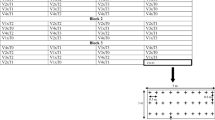Abstract
The effect of irrigation regimes on disease expression in melon plants infected with Monosporascus cannonballuswas studied during two summer growing seasons (1998 and 1999) in the Arava region of southern Israel. Less frequent and reduced irrigation postponed the onset of plant collapse and lowered disease incidence. Delaying disease development in infested fields by reducing irrigation frequency allowed crop harvest before plant collapse. However, reduced irrigation regimes reduced yields, as shown in methyl bromide fumigated plots. Fruits from melon plants grown under reduced irrigation in the infested plots were also of lower quality due to water shortage. The delay in plant collapse under the reduced irrigation treatments was attributed to a combined effect of reduced fruit load and the development of a deeper root system, which could support the increased water demand of the mature, fruiting plant.
Similar content being viewed by others
References
Campbell CL and Madden LV (1990) Introduction to Plant Disease Epidemiology, Wiley, New York
Cohen R, Elkind Y, Burger Y, Offenbach R and Nerson H (1996) Variation in the response of melon genotypes to sudden wilt. Euphytica 87: 91-95
Cohen R, Pivonia S, Burger Y, Edelstien M, Gamliel A and Katan J (2000) Toward integrated management of Monosporascus wilt of melons in Israel. Plant Disease 84: 496-505
Crosby K and Wolff D (1998) Effects of Monosporascus cannonballus on root traits of susceptible and tolerant melon (Cucmis melo L.) cultivars. In: McCreight JD (ed) Cucurbitaceae 98. Evaluation and Enhancement of Cucurbit Germplasma (pp 253-256) ASHS Press, Alexandria, VA
Crosby K, Wolff D and Miller M (2000) Comparison of root morphology in susceptible and tolerant melon cultivars before and after infection by Monosporascus cannonballus. HortScience 35: 681-683
Dias R de CS, Pico B, Herraiz J, Espinos A and Nuez F (2002) Modifying root structure of cultivated muskmelon to improve vine decline resistance. HortScience 37: 1092-1097
Edelstein M, Cohen R, Shariber S, Pivonia S and Shteinberg D (1999) Integrated management of sudden wilt in melons, caused by Monosporascus cannonballus, using grafting and reduced rates of methyl bromide. Plant Disease 83: 1142-1145
El-Keblawy A and Lovett-Doust J (1996) Resource re-allocation following fruit removal in cucurbits: Patterns in cantaloupe melons. New Phytologist 134: 413-422
Marcelis LFM (1994) Effects of fruit growth, temperature and irradiance on biomass allocation to the vegetative parts of cucumber. Netherlands Journal of Agricultural Science 42: 115-123
Martyn RD and Miller ME (1996) Monosporascus root rot and vine decline, an emerging disease of melons worldwide. Plant Disease 80: 716-725
Mertely JC, Martyn RD, Miller ME and Bruton BD (1993) An expanded host range for the muskmelon pathogen Monosporascus cannonballus. Plant Disease 77: 667-673
Palti J and Katan J (1997) Effect of cultivation practices and cropping systems on soilborne diseases. In: Hillocks RJ and Waller JM (eds) Soilborne Diseases of Tropical Crops (pp. 377-396) CAB International
Pivonia S, Cohen R, Kafkafi U, Ben Ze'ev IS and Katan J (1997) Sudden wilt of melons in southern Israel: Fungal agents and relationship with plant development. Plant Disease 81: 1264-1268
Randall HC and Locascio SJ (1988) Root growth and water status of trickle-irrigated cucumber and tomato. HortScience 113: 830-853
Reuveni R, Krikun J and Shani U (1983) The role of Monosporascus eutypoides in a collapse of melon plants in an arid area of Israel. Phytopathology 73: 1223-1226
Shani U, Waisel Yand EshelA(1995) The development of melon roots under trickle irrigation: Effect of the location of the emitters. In: Baluska F et al. (eds) Structure and Function of Roots (pp 223-225) Kluwer Academic Publishers, Dordrecht
Stanghellini ME, Kim DH and Rasmussen SL (1996) Ascospores of Monosporascus cannonballus: Germination and distribution on cultivated and desert soils in Arizona. Phytopathology 86: 509-514
de Stigter HCM (1969) Growth relations between individual fruits, and between fruits and roots in cucumber. Netherlands Journal of Agricultural Science 17: 209-214
Wolff DW and Miller ME (1998) Tolerance to Monosporascus root rot and vine decline in melon (Cucumis melo L.) germplasm. HortScience 33: 287-290
Author information
Authors and Affiliations
Corresponding author
Rights and permissions
About this article
Cite this article
Pivonia, S., Cohen, R., Cohen, S. et al. Effect of Irrigation Regimes on Disease Expression in Melon Plants Infected with Monosporascus cannonballus . European Journal of Plant Pathology 110, 155–161 (2004). https://doi.org/10.1023/B:EJPP.0000015341.95455.22
Issue Date:
DOI: https://doi.org/10.1023/B:EJPP.0000015341.95455.22




